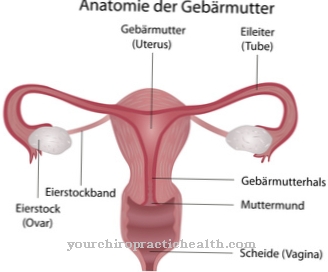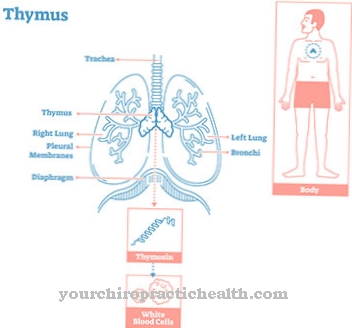One condition that can affect toddlers and babies as well as adults and the elderly is that Candidosis, which is also colloquially known as thrush is known.
What is thrush?
.jpg)
© H_Ko - stock.adobe.com
At the Thrush (candidiasis) typical abnormal changes in the skin are observed. In this regard, with thrush there are mainly disturbing and extremely unpleasant complaints and abnormalities on the mucous membranes of the sick.
Depending on the symptoms, thrush can be described as an infectious disease that can affect the lining of the mouth, vagina, penis, esophagus, and other organs.
One differentiates candidiasis as follows:
- Skin thrush in the area of the skin, anus, armpits and skin folds
- Oral thrush in the area of the throat and mouth
- oesophageal candidiasis in the esophagus
- intestinal candidiasis in the area of the intestine
Thrush is just a skin disease which, along with other clinical pictures from this group, can cause very peculiar symptoms.
The term candidiasis is based on yeasts of the Candida family. In connection with thrush, the yeast Candida albicans must be highlighted. The most widespread under the name thrush (candidosis) is the so-called Oral thrushwhich is represented by an increased occurrence of the yeast Candida albicans. This disease is more common in babies in particular.
causes
As causes for the emergence of thrush only the named molds of the species Candida albicans come into consideration. These are contained in a healthy body and multiply due to various influencing factors, which can lead to candidiasis.
Excessive colonization of the mucous membranes, which have a warm and humid environment, which is very fungus-friendly, and a limited immune defense, the yeasts can spread there. In addition, not all causes for the formation of thrush are known, which can affect many internal organs and in some cases even assume life-threatening proportions.
An altered metabolism, which occurs predominantly in patients with diabetes mellitus, can also be a causal trigger for thrush. People with cancer, people infected with HIV or those treated with special medication can also develop candidiasis. In many cases, thrush is also triggered and transmitted by a lack of hygiene.
Symptoms, ailments & signs
The yeast can attack different parts of the body. The complaints that arise are correspondingly diverse. On the skin, it is preferred to attack areas which have folds of skin lying one above the other. The warm, humid environment creates ideal growth conditions for the yeast. Therefore, reddened skin often occurs in the armpits or under the breasts.
The skin areas swell and become sensitive to touch. Dandruff is also common. The skin is itchy and wet. A red border around the affected area is typical of candidiasis of the skin. This is called a so-called ruff scaling. Pustules can also form on the inflamed skin.
If thrush occurs in the oral cavity, the affected areas appear red and have a whitish coating. If the throat area is affected, there will be discomfort when swallowing. Thrush can spread to the esophagus and also affect the digestive tract. If thrush occurs in the vaginal area, redness and itching occur.
A coarse-grained white discharge can also indicate the clinical picture. If the glans penis is affected in men, blisters can form. In most people, the fungus can be detected in the mouth and intestinal area without causing symptoms. If the immune system is disturbed, this promotes the development of thrush. The symptoms mentioned occur particularly in young children and old people.
Complications
As a result of systemic candidiasis, serious complications can occur throughout the body. Depending on where the pathogens settle, it can lead to brain, lung, kidney, heart valve and retinal inflammation, for example. If the pathogens get into the blood, this causes Candida blood poisoning.
If the thrush occurs in the genital area, this can lead to the formation of pustules and papules as well as excruciating itching. Cutaneous thrush is usually associated with skin irritation, which can lead to abscesses and serious infections if the treatment is inadequate or not treated. Oral thrush can cause discomfort in the lining of the mouth and throat.
Difficulty swallowing, pain in the esophagus and a strong burning sensation behind the breastbone are typical. In the worst case, intestinal thrush can lead to chronic intestinal diseases or even to constipation and intestinal obstruction. The therapy of a thrush infection also carries risks.
The prescribed antimycotics can cause side effects and interactions such as reddening of the skin, itching and burning. Allergic reactions, swelling, or hives are rare.Medicines such as econazole can cause allergic reactions in allergy sufferers. A general intolerance to the respective active ingredients is also conceivable and associated with undesirable symptoms.
When should you go to the doctor?
Changes and abnormalities in the appearance of the skin should be presented to a doctor as soon as they increase or suddenly persist for several days. Candidiasis causes discomfort in the mucous membranes. Particular care is required in the area of the mouth, throat or intestines. A doctor is needed if symptoms arise that impair well-being.
If the person concerned suffers from irregular swallowing, a tightness in the throat or pain, a doctor's visit is necessary. Refusal to eat or drink fluids should be reported to a doctor. In severe cases it can lead to dehydration and thus a potential danger to life.
A dentist should examine problems with the dentures or changes in the position of the teeth. A doctor is needed in the event of internal weakness, malaise or a decrease in physical resilience. Redness, the formation of pustules or swelling are signs of a health problem. A doctor is needed as soon as a discharge develops, digestive tract disorders or irregularities in using the toilet appear.
If there are peculiarities in the genital organs, if there is a decreased libido or sexual dysfunction, a doctor's assessment is indicated. Itching, restlessness and pain are other indications that should be investigated.
Treatment & Therapy
As part of effective treatment against thrush different concepts are implemented. These depend on the form of the candidiasis and its location as well as the current stage of the disease. Usually dermatologists use antifungal drugs against thrush, i.e. drugs that work against fungi. These are selected based on the type of skin fungus.
As external applications against thrush, which are only used locally, various brushings and liquids for rinsing as well as antifungal, anti-inflammatory and itch-relieving ointments and creams are suitable.
Vaginal candidiasis is fought with special vaginal suppositories. Some medicines for the Candida albicans fungus are prescribed in tablet form.
In so-called systemic thrush, infusions or tablets such as miconazole, clotrimazole, ketonazole and amphotericin B.
prevention
To one thrush To prevent this, it is important to watch out for a healthy immune system and to support it with a healthy lifestyle. Medicines such as suitable antibiotics and drugs containing cortisone are suitable as prophylactic precautions against candidiasis in the case of previous illnesses such as AIDS and diabetes mellitus and cancer with chemotherapy. Appropriate oral and intimate hygiene also help prevent excessive formation of the Candida albicans fungus and thrush (candidiasis).
Aftercare
The aftercare treatments for thrush present many possibilities. Drug treatment with antimycotics for thrush must in any case, according to the doctor and pharmacy, be carried out continuously until the end of treatment. This means that the drug should be taken after the symptoms have subsided.
This completely eliminates the pathogens that led to thrush. With the follow-up care the healthy and hygienic lifestyle of the patient is paid attention to. A healthy diet is generally encouraged. In adults, nicotine consumption should be avoided as far as possible or completely. When using braces, partial and full dental prostheses, particular care must be taken to ensure thorough cleaning and hygienic dental prosthesis and oral care.
When following up small children with thrush, all objects and toys that have come into contact with the child's mouth must be hygienically cleaned. Parents should also take care to avoid contact with the mouth and saliva of the infected child. With these measures in aftercare, the renewed outbreak of a thrush disease in the patient and the infection of other people with thrush are largely excluded and prevented.
You can do that yourself
In order to contain and alleviate the symptoms, the person affected can ensure that no hot and humid areas form on the skin due to the loss of body fluids. These provide the ideal conditions for the fungi to grow and spread on the skin. Applying body powder to existing risk areas helps so that the skin dries better.
In addition, good personal hygiene is important to make it more difficult for the pathogens to multiply. The clothing must be checked for its ingredients. Some fibers promote the development of warm, humid regions on the skin because they do not absorb sweat. It is therefore important to ensure that the items of clothing contain only a small amount of polyester and a large amount of cotton. Regular showering, changing sleeping utensils and changing clothes worn every day help to improve the health of those affected.
In the case of complaints in the area of the throat or mouth, irritating foods should not be consumed. The consumption of concentrates or acidic nutrients should therefore be avoided. Although there may be loss of appetite or discomfort in the mouth and esophagus, it is important that a balanced and healthy diet is taken. It is not beneficial for the recovery process if you do not eat meals.





.jpg)





















